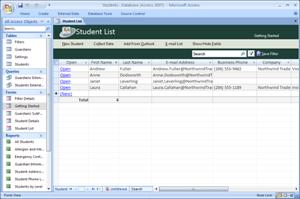Use the Students Access database template
Use the Access 2007 Student database template to keep track of information about your students, including emergency contacts, medical information, and information about their guardians. You can also search and filter students, track student attendance, show or hide columns, and map student addresses.

Using the database
In this article, we cover the basic steps of using the Students database template.
Prepare the database for use
-
When you first open the database, Access displays the Getting Started page. To prevent this page from displaying the next time you open the database, clear the Show Getting Started when this database is opened check box.
Close the Getting Started page to begin using the database.
-
To make sure all the database content is enabled, use the following procedure:
-
In the Message Bar, click Options.
-
In the Microsoft Office Security Options dialog box, click Enable this content, and then click OK.
For more information about enabling database content, see the article Decide whether to trust a database.
-
Collect data through e-mail
You can collect student information from e-mail users by sending them a data entry form in an e-mail message. When users return the completed form, the data can be processed and stored in your student list.
-
On the Asset List form, click Collect Data.
-
Follow the instructions in the Collect data through e-mail messages wizard to collect data from the specified e-mail recipients.
Search for a student
The Quick Search box lets you quickly find an student on the Student List form.
-
Type the text you want to search for in the Quick Search box, and then press ENTER or click Go.
Access filters the list to show only those records that contain the text you searched for. To return to the full list, click Show All Records.
Filter the Student list
On the Student List form, you can filter the list of students, and save your favorite filters for future use.
-
Apply filters by right-clicking the form and selecting the filters you want.
-
Click Save Filter.
-
On the Filter Details form, enter a filter name and description, and then click Close.
-
Use the Filter Favorites box to apply a saved filter, or click (Clear Filter) to remove the filter.
Show or hide columns
On the Student List form, some fields (columns) are hidden by default. To change which fields are displayed:
-
Click Show/Hide Fields.
-
In the Unhide Columns dialog box, select the check box beside each column that you want to show. Clear the check box to hide the column.
Display student details
The Student Details form lets you view and enter more information about a student, including pictures, guardians, emergency information, and attendance. To display the Student Details form:
-
On the Student List form, click Open next to the item that you want to see.
Add a picture
On the Student Details form, you can add pictures and other attachments.
-
Under the picture frame, click + / – Images.
-
In the Attachments dialog box, click Add.
-
In the Choose File dialog box, browse to the folder that contains the file.
-
Select the file you want to add, and then click Open.
-
In the Attachments dialog box, click OK.
Note: You can attach multiple files for each item, including different file types such as documents or spreadsheets.
Add students from Microsoft Office Outlook 2007
If you use Office Outlook 2007, you can add students from that program without having to re-type the information.
-
On the Student List form, click Add From Outlook.
-
In the Select Names to Add dialog box, select the names that you want to add to the database.
-
Click Add, and then click OK.
Display a map of a student's address
On the Student Details form, if you have entered a street address for the student, you can display a map of that location:
-
Click Click to Map.
Display reports
The Students database includes several reports, including All Students, Allergies and Medications, Emergency Contact Information, Guardian Information, and more. To display a report:
-
In the Navigation Pane, under Reports, double-click the report you want to display.
You can create your own custom reports. For more information, see the article Create a simple report.
No comments:
Post a Comment